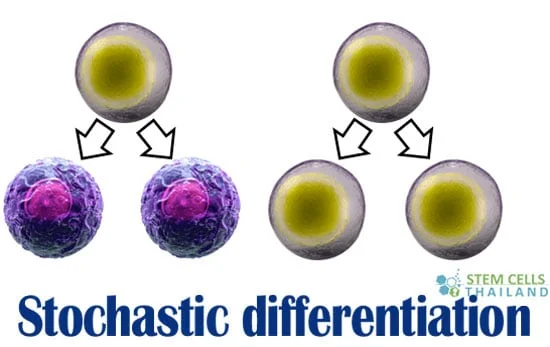
Stochastic differentiation refers to the process in which a stem cell undergoes division, giving rise to two daughter cells that are differentiated.[1]
On the other hand, another stem cell goes through the process of differentiation or mitosis to generate two stem cells that are similar to its original cell state, thereby maintaining stem cell number.[2] This process of differentiation is necessary for stem cells to maintain their number (stem cell reserve) in the body.[3]
Stochastic differentiation refers to the process of cellular differentiation that is influenced by random events, rather than purely deterministic, pre-programmed pathways. In the context of stem cell biology and development, the differentiation of cells can be influenced by a combination of intrinsic and extrinsic factors. While certain differentiation pathways are deterministic and driven by specific molecular cues, stochastic events can introduce variability into these processes.
When one father stem cell divides into 2 differentiated daughter cells. a second father cell divides into two stem cells to maintain the population.
In stem cell populations, stochastic differentiation can lead to diverse cell fates even within a seemingly homogenous population. For instance, a population of identical stem cells might differentiate into multiple cell types due to stochastic events, leading to a heterogeneous mixture of differentiated cells.
While many cellular differentiation events are deterministic and follow well-defined pathways, stochasticity introduces an element of randomness. Recognizing and understanding the role of stochastic differentiation is essential for various fields, from developmental biology to medicine.
[1] ^ Hayashi, Shin-Ichi, Akihiko Murata, Kazuki Okuyama, Yuhki Shimoda, Mari Hikosaka, Hisataka Yasuda, and Miya Yoshino. 2012. Stochastic differentiation into an osteoclast lineage from cloned macrophage-like cells. Biochemical and biophysical research communications, no. 2 (October 22). doi:10.1016/j.bbrc.2012.10.052. https://www.ncbi.nlm.nih.gov/pubmed/23085228.
[2] ^ Sturrock, Marc, Andreas Hellander, Anastasios Matzavinos, and Mark A J Chaplain. 2013. Spatial stochastic modelling of the Hes1 gene regulatory network: intrinsic noise can explain heterogeneity in embryonic stem cell differentiation. Journal of the Royal Society, Interface, no. 80 (January 16). doi:10.1098/rsif.2012.0988. https://www.ncbi.nlm.nih.gov/pubmed/23325756.
[3] ^ Tarlinton, David. 2012. B-cell differentiation: instructive one day, stochastic the next. Current biology : CB, no. 7 ( 10). doi:10.1016/j.cub.2012.02.045. https://www.ncbi.nlm.nih.gov/pubmed/22497941.
If you've seen people take ice baths or cold showers and wondered if they're onto… Read More
Immunomodulation stands at the forefront of biomedical research, steering the immune system's ability to fight… Read More
Stem cell research leads the charge in medical innovation, heralding revolutionary advances in regenerative medicine.… Read More
The blood-brain barrier (BBB) is a crucial shield for the brain, regulating the entry of… Read More
While peptide bonds are fundamental to protein structure, their direct relationship with stem cells lies… Read More
When discussing cutting-edge cancer treatments, NK cell therapy stands out due to its unique approach… Read More